Scientometric Analysis and Research Trends in Optical Fiber Grating Sensors: A Review
Abstract
1. Introduction
- (1)
- Periodicity-Based Classification
- Fiber Bragg gratings (FBGs): These gratings operate by reflecting specific wavelengths of light based on Bragg’s law, with the reflected wavelength determined by the grating period. Their short-period structure ensures high precision in sensing applications, particularly for measuring strain [12,13], temperature [14,15], and pressure [16,17]. FBGs are widely applied in distributed sensing networks for structural health monitoring, aerospace, and energy sectors.
- Long-period fiber gratings (LPFGs): Unlike FBGs, LPFGs have a longer grating period, which couples light from the core into cladding modes, leading to enhanced sensitivity to external refractive index changes. This makes LPFGs particularly suitable for applications in biochemical sensing [18,19] and environmental monitoring [20,21]. Unlike FBGs, which reflect specific wavelengths, LPFGs transmit light and modulate specific wavelengths.
- (2)
- Structural Enhancements
- Phase-shift fiber gratings (PS-FGs): These introduce a phase shift at a specific point within the grating, resulting in a narrowband reflection peak. By interrupting the uniformity of refractive index modulation, PS-FGs are ideal for high-resolution optical filtering and ultra-narrow bandwidth sensor applications [22,23,24].
- Tilted fiber Bragg gratings (TFBGs): The grating fringes in TFBGs are slanted relative to the fiber axis, enabling the coupling of core modes into cladding modes. This design enhances sensitivity to transverse strain, bending, and surrounding refractive index changes, making TFBGs useful for polarization-sensitive [25,26,27] and multi-parameter sensing [28,29].
- D-Shaped fiber gratings: These are created by polishing one side of the fiber, exposing the core and enabling the evanescent field to interact with the surrounding environment. This enhances sensitivity to surface perturbations, making them particularly effective for biochemical [32,33] and environmental sensing [34,35]. However, the polishing process reduces the mechanical strength of the fiber.
- (3)
- Advanced Sensing Mechanisms
- Surface plasmon resonance (SPR)-based gratings: These sensors incorporate a metallic coating, allowing interaction between the evanescent field and free electrons in the metal. When the resonance condition is met, a sharp drop in transmitted light intensity occurs, making SPR highly sensitive to refractive index changes. This technology is widely used in chemical [36,37] and biological sensing [38,39].
- Vernier-effect fiber gratings: This effect is achieved by combining two gratings with slightly different periods, resulting in an interference pattern that amplifies sensor sensitivity. The Vernier effect is particularly valuable in applications requiring ultra-high precision, such as strain [40,41], temperature [42,43], or pressure sensing [44].
- Polarization-sensitive fiber gratings: Gratings such as TFBGs interact differently with light polarization states. By exploiting polarization-dependent loss or birefringence, these sensors can detect multiple parameters simultaneously, including stress and temperature [45,46].They are widely used in applications where multi-axis strain or anisotropic environmental changes need to be monitored.
- (4)
- Integration with Optical Fiber Types
- Single-mode fiber (SMF) gratings: The integration of FBGs with SMF remains the standard for reliable strain and temperature sensing due to their low-loss transmission characteristics.
- Few-mode fiber (FMF) gratings: FMF-based FBGs increase sensing capacity by supporting multiple propagation modes, allowing for advanced multiplexing while maintaining manageable complexity.
- Multi-core fiber (MCF) gratings: MCFs combined with FBGs enable distributed sensing over multiple cores, improving spatial resolution and multi-parameter monitoring capabilities.
- Photonic crystal fiber (PCF) gratings: These gratings leverage a microstructured arrangement of air holes to enhance sensitivity by allowing for tailored light propagation, leading to improved detection capabilities.
- D-shaped fiber gratings: As previously mentioned, D-shaped fibers enable evanescent field interaction, making them highly sensitive to surface changes and suitable for biochemical sensing applications.
2. Data and Methods
2.1. Data Collection and Processing
- Registration Platform: Open Science Framework (OSF);
- Registration Date: 4 March 2025;
- Registration Number: 10.17605/OSF.IO/M3C9D;
- Protocol Access: https://osf.io/m3c9d/.
2.1.1. Data Source and Selection
2.1.2. Data Coverage and Selection Criteria
2.2. Scientometrics Analysis Method
3. Scientometric Analysis
3.1. Statistical Characteristics
3.2. Subject Structure Analysis and Influential Sources
3.3. Research Contribution Analysis (Core Authors)
3.4. Analysis of the History and the Current Research Hotspots
3.4.1. Keyword Co-Occurrence Analysis
3.4.2. Evolutionary Trends and Hot Topics
4. Challenges and Technological Advancements
4.1. Environmental Limitations and Reliability Concerns
4.2. Competitive Analysis with Alternative Sensing Technologies
4.3. Emerging Solutions and Future Development Trends
5. Conclusions
Author Contributions
Funding
Institutional Review Board Statement
Informed Consent Statement
Data Availability Statement
Acknowledgments
Conflicts of Interest
Abbreviations
| OFGS | Optical Fiber Grating Sensor |
| FBG | Fiber Bragg Grating |
| LPFG | Long Period Fiber Grating |
| PS-FG | Phase-Shift Fiber Grating |
| TFBG | Tilted Fiber Bragg Grating |
| SPR | Plasmon Resonance |
| SMF | Single-Mode Fiber |
| FMF | Few-Mode Fiber |
| MCF | Multi-Core Fiber |
| PCF | Photonic Crystal Fiber |
| WoS | Web of Science |
| AI | Artificial Intelligence |
| IoT | Internet of Things |
| DFOS | Distributed Fiber Optic Sensor |
References
- Young, G.O.; Hill, K.O.; Fujii, Y.; Johnson, D.C.; Kawasaki, B.S. Synthetic structure of industrial plastics. Plastics 1978, 32, 647–649. [Google Scholar]
- Minakuchi, S.; Takeda, N. Recent advancement in optical fiber sensing for aerospace composite structures. Photonic Sens. 2013, 3, 345–354. [Google Scholar] [CrossRef]
- Hegde, G.; Asokan, S.; Hegde, G. Fiber Bragg grating sensors for aerospace applications: A review. ISSS J. Micro Smart Syst. 2022, 11, 257–275. [Google Scholar] [CrossRef]
- Wu, T.; Liu, G.; Fu, S.; Xing, F. Recent Progress of Fiber-Optic Sensors for the Structural Health Monitoring of Civil Infrastructure. Sensors 2020, 20, 4517. [Google Scholar] [CrossRef]
- Wang, H.; Dai, J.G. Strain transfer analysis of fiber Bragg grating sensor assembled composite structures subjected to thermal loading. Compos. Part. B Eng. 2019, 162, 303–313. [Google Scholar] [CrossRef]
- Rajeev, P.; Kodikara, J.; Chiu, W.K.; Kuen, T. Distributed Optical Fibre Sensors and their Applications in Pipeline Monitoring. Key Eng. Mater. 2013, 558, 424–434. [Google Scholar] [CrossRef]
- Zhu, Y.; Chen, W.; Fu, Y.; Huang, S. A review of harsh environment fiber optic sensing networks for bridge structural health monitoring. In Proceedings of the SPIE OPTICS + PHOTONICS, San Diego, CA, USA, 13–17 August 2006; Volume 6314, p. 63140. [Google Scholar]
- Murayama, H.; Igawa, H.; Omichi, K.; Machijima, Y. Application of distributed sensing with long length FBG to structural health monitoring. In Proceedings of the 9th International Conference on Optical Communications and Networks (ICOCN 2010), Nanjing, China, 24–27 October 2010; Volume 18, pp. 18–24. [Google Scholar]
- Afzal, M.H.B.; Kabir, S.; Sidek, O. Fiber optic sensor-based concrete structural health monitoring. In Proceedings of the 2011 Saudi International Electronics, Communications and Photonics Conference (SIECPC), Riyadh, Saudi Arabia, 24–26 April 2011; pp. 1–5. [Google Scholar]
- Wild, G.; Allwood, G.; Hinckley, S. Distributed sensing, communications, and power in optical Fibre Smart Sensor networks for structural health monitoring. In Proceedings of the 2010 Sixth International Conference on Intelligent Sensors, Sensor Networks and Information Processing, Brisbane, QLD, Australia, 7–10 December 2010; pp. 139–144. [Google Scholar]
- Wang, D.Y.; Wang, Y.; Han, M.; Gong, J.; Wang, A. Fully distributed fiber-optic biological sensing. IEEE Photonics Technol. Lett. 2010, 22, 1553–1555. [Google Scholar] [CrossRef]
- You, R.Z.; Ren, L.; Song, G.B. A novel fiber Bragg grating (FBG) soil strain sensor. Measurement 2019, 139, 85–91. [Google Scholar] [CrossRef]
- Qin, H.Y.; Tang, P.F.; Lei, J.; Chen, H.B.; Luo, B.G. Investigation of Strain-Temperature Cross-Sensitivity of FBG Strain Sensors Embedded Onto Different Substrates. Photonic Sens. 2022, 13, 230127. [Google Scholar] [CrossRef]
- Kang, D.; Kim, H.Y.; Kim, D.H. Thermal characteristics of FBG sensors at cryogenic temperatures for structural health monitoring. Int. J. Precis. Eng. Manuf. 2016, 17, 5–9. [Google Scholar] [CrossRef]
- Peng, J.; Jia, S.; Yu, H.; Kang, X.; Yang, S.; Xu, S. Design and Experiment of FBG Sensors for Temperature Monitoring on External Electrode of Lithium-Ion Batteries. IEEE Sens. J. 2021, 21, 4628–4634. [Google Scholar] [CrossRef]
- Gowda, R.B.; Sharan, P.; K, S.; Braim, M.; Alodhayb, A.N. An FBG-based optical pressure sensor for the measurement of radial artery pulse pressure. J. Biophotonics 2024, 17, e202400083. [Google Scholar] [CrossRef] [PubMed]
- Rosolem, J.B. Electroless Nickel-Plating Sealing in FBG Pressure Sensor for Thermoelectric Power Plant Engines Applications. J. Light. Technol. 2019, 37, 4791–4798. [Google Scholar]
- Dey, T.K.; Biswas, P.; Basumallick, N.; Bandyopadhyay, S. Long Period Fiber Grating Near Turn Around Point: Suitable Design for Bio-Sensing. IEEE Sens. J. 2021, 21, 18800–18805. [Google Scholar]
- Baliyan, A.; Sital, S.; Tiwari, U.; Gupta, R.; Sharma, E.K. Long period fiber grating based sensor for the detection of triacylglycerides. Biosens. Bioelectron. 2016, 79, 693–700. [Google Scholar]
- Wang, R.; Ren, Z.; Kong, X.; Kong, D.; Hu, B.; He, Z. Graphene-assisted high-precision temperature sensing by long-period fiber gratings. J. Phys. D Appl. Phys. 2019, 53, 065104. [Google Scholar]
- Wu, C.W.; Chiang, C.C. Application of Notched Long-Period Fiber Grating Based Sensor for CO2 Gas Sensing. Fiber Integr. Opt. 2016, 35, 22–28. [Google Scholar] [CrossRef]
- Liu, T. Simultaneous Detection of Temperature, Strain, Refractive Index, and pH Based on a Phase-Shifted Long-Period Fiber Grating. J. Light. Technol. 2023, 41, 5169–5180. [Google Scholar] [CrossRef]
- Chen, M.Q.; He, T.Y.; Zhao, Y.; Yang, G. Ultra-short phase-shifted fiber Bragg grating in a microprobe for refractive index sensor with temperature compensation. Opt. Laser Technol. 2023, 156, 108672. [Google Scholar]
- Min, R.; Marques, C.; Bang, O.; Ortega, B. Moiré phase-shifted fiber Bragg gratings in polymer optical fibers. Opt. Fiber Technol. 2018, 41, 78–81. [Google Scholar]
- Lu, Y.F.; Shen, C.Y.; Chen, D.B.; Chu, J.L.; Wang, Q.; Dong, X.Y. Highly sensitive twist sensor based on tilted fiber Bragg grating of polarization-dependent properties. Opt. Fiber Technol. 2014, 20, 491–494. [Google Scholar] [CrossRef]
- Bialiayeu, A.; Ianoul, A.; Albert, J. Polarization-resolved sensing with tilted fiber Bragg gratings: Theory and limits of detection. J. Opt. 2015, 17, 085601. [Google Scholar]
- Kisała, P.; Mroczka, J.; Cięszczyk, S.; Skorupski, K.; Panas, P. Twisted tilted fiber Bragg gratings: New structures and polarization properties. Opt. Lett. 2018, 43, 4445–4448. [Google Scholar]
- Yan, Y.X.; Gu, Z.T.; Jiang, H.P.; Li, Z.Y.; Wu, J.Y.; Wang, Y. Design and simulation of a hybrid coated LPG-TFBG-FBG three-parameter sensor for an ocean environment. J. Opt. Soc. Am. B 2022, 39, 2109–2119. [Google Scholar]
- Jiang, Y.; Hao, Z.; Feng, D.; Zhou, K.; Zhang, L.; Zhao, J. Hybrid Grating in Reduced-Diameter Fiber for Temperature-Calibrated High-Sensitivity Refractive Index Sensing. Appl. Sci. 2019, 9, 1923. [Google Scholar] [CrossRef]
- Feng, M.; Liu, Y.; Wang, Z.; Mao, B.; Zhang, H. Ultra-Broadband Mode Converter Using Cascading Chirped Long-Period Fiber Grating. IEEE Photonics J. 2019, 11, 1–10. [Google Scholar]
- Zhao, X. Bandwidth Tunable Ultra-Broadband OAM Generators Based on Chirped Long Period Fiber Gratings at Dispersion Turning Point. J. Light. Technol. 2024, 42, 4980–4986. [Google Scholar]
- Fang, H.; Wei, C.; Yang, H. D-Shaped Photonic Crystal Fiber Plasmonic Sensor Based on Silver-Titanium Dioxide Composite Micro-grating. Plasmonics 2021, 16, 2049–2059. [Google Scholar] [CrossRef]
- Erdogan, İ.; Dogan, Y. Au-TiO2-Graphene Grated Highly Sensitive D-Shaped SPR Refractive Index Sensor. Plasmonics 2023, 18, 1203–1210. [Google Scholar] [CrossRef]
- Ying, Y.; Zhang, R.; Si, G.-Y.; Wang, X.; Qi, Y.-W. D-shaped tilted fiber Bragg grating using magnetic fluid for magnetic field sensor. Opt. Commun. 2017, 405, 228–232. [Google Scholar] [CrossRef]
- Yan, H.T.; Liu, Q.; Ming, Y.; Luo, W.; Chen, Y.; Lu, Y.Q. Metallic Grating on a D-Shaped Fiber for Refractive Index Sensing. IEEE Photonics J. 2013, 5, 4800706. [Google Scholar] [CrossRef]
- Raghuwanshi, S.K.; Kumar, M.; Jindal, S.K.; Kumar, A.; Prakash, O. High-Sensitivity Detection of Hazardous Chemical by Special Featured Grating-Assisted Surface Plasmon Resonance Sensor Based on Bimetallic Layer. IEEE Trans. Instrum. Meas. 2020, 69, 5072–5080. [Google Scholar] [CrossRef]
- Huang, C.; Zhou, Y.; Yu, G.; Zeng, J.; Li, Q.; Shen, K.; Wu, X.; Guo, R.; Zhang, C.; Zheng, B. Glutathione-functionalized long-period fiber gratings sensor based on surface plasmon resonance for detection of As3+ ions. Nanotechnology 2023, 32, 485501. [Google Scholar] [CrossRef]
- Moreno, Y.; Song, Q.; Xing, Z.; Sun, Y.; Yan, Z. Hybrid tilted fiber gratings-based surface plasmon resonance sensor and its application for hemoglobin detection. Chin. Opt. Lett. 2020, 18, 100601. [Google Scholar] [CrossRef]
- Lobry, M.; Loyez, M.; Debliquy, M.; Chah, K.; Goormaghtigh, E.; Caucheteur, C. Electro-plasmonic-assisted biosensing of proteins and cells at the surface of optical fiber. Biosens. Bioelectron. 2023, 220, 114867. [Google Scholar] [CrossRef] [PubMed]
- Tian, X.; Shi, J.; Wang, Y.; Li, L.; She, Y. Sensitivity Enhancement for Fiber Bragg Grating Strain Sensing Based on Optoelectronic Oscillator With Vernier Effect. IEEE Photonics J. 2021, 13, 1–6. [Google Scholar]
- Wang, X.; Chen, T.; Meng, D.; Wang, F. A Simple FBG Fabry–Perot Sensor System With High Sensitivity Based on Fiber Laser Beat Frequency and Vernier Effect. IEEE Sens. J. 2021, 21, 71–75. [Google Scholar]
- Liu, F.; Zhang, Y.; Meng, F.; Dong, M.; Zhu, L.; Luo, F. Complex optical fiber sensor based on the Vernier effect for temperature sensing. Opt. Fiber Technol. 2021, 61, 102424. [Google Scholar] [CrossRef]
- Su, H.; Zhao, C.; Song, X.; Kong, F.; Zhang, Z.; Liu, C. High-sensitivity optical fiber temperature sensor with cascaded configuration of MZI and FPI based on Vernier effect. Opt. Fiber Technol. 2021, 67, 102751. [Google Scholar] [CrossRef]
- Bell, K.; Mukhangaliyeva, L.; Khalili, L.; Reza, P.H. Hyperspectral absorption microscopy using photoacoustic remote sensing. Opt. Express 2021, 29, 24338–24348. [Google Scholar] [CrossRef]
- Leal-Junior, A.; Silveira, M.; Macedo, L.; Frizera, A.; Marques, C. Polarization-Assisted multiparameter sensing using a single fiber Bragg grating. Opt. Fiber Technol. 2024, 84, 103775. [Google Scholar] [CrossRef]
- Esposito, F.; Srivastava, A.; Iadicicco, A.; Campopiano, S. Multi-parameter sensor based on single Long Period Grating in Panda fiber for the simultaneous measurement of SRI, temperature and strain. Opt. Laser Technol. 2019, 113, 198–203. [Google Scholar] [CrossRef]
- Zhao, Y.; Song, T.-T. Fiber bragg grating current sensor based on birefringence effect. Microw. Opt. Technol. Lett. 2012, 54, 822–826. [Google Scholar] [CrossRef]
- Tang, J. Long Period Fiber Grating Inscribed in Hollow-Core Photonic Bandgap Fiber for Gas Pressure Sensing. IEEE Photonics J. 2017, 9, 1–7. [Google Scholar] [CrossRef]
- Chen, Y.; Han, Q.; Yan, W.; Yao, Y.; Liu, T. Magnetic-Fluid-Coated Photonic Crystal Fiber and FBG for Magnetic Field and Temperature Sensing. IEEE Photonics Technol. Lett. 2016, 28, 2665–2668. [Google Scholar] [CrossRef]
- Chen, C.; Ibekwe-SanJuan, F.; Hou, J. The structure and dynamics of cocitation clusters: A multiple-perspective cocitation analysis. J. Am. Soc. Inf. Sci. Technol. 2010, 61, 1386–1409. [Google Scholar]
- Chen, C. Predictive effects of structural variation on citation counts. J. Am. Soc. Inf. Sci. Technol. 2012, 63, 431–449. [Google Scholar]
- Chen, C. Science Mapping: A Systematic Review of the Literature. J. Data Inf. Sci. 2017, 2, 1–40. [Google Scholar]
- Chen, C.; Song, M. Visualizing a Field of Research: A Methodology of Systematic Scientometric Reviews. PLoS ONE 2019, 14, 0223994. [Google Scholar]
- Chen, C. Hindsight, insight, and foresight: A multi-level structural variation approach to the study of a scientific field. Technol. Anal. Strateg. Manag. 2013, 25, 619–640. [Google Scholar]
- Morey, W.W.; Meltz, G.; Glenn, W.H. Fiber optic Bragg grating sensors. Fiber Opt. Laser Sens. 1990, 1169, 98–107. [Google Scholar]
- Vengsarkar, A.M. Long-period fiber gratings as band-rejection filters. J. Light. Technol. 1996, 14, 58–65. [Google Scholar] [CrossRef]
- Kersey, A.D. Fiber grating sensors. J. Light. Technol. 1997, 15, 1442–1463. [Google Scholar] [CrossRef]
- Rao, Y. “In-fibre Bragg grating sensors” Meas. Sci. Technol. 1997, 8, 355–375. [Google Scholar] [CrossRef]
- Mihailov, S.J. Fiber Bragg Grating Sensors for Harsh Environments. Sensors 2012, 12, 1898–1918. [Google Scholar] [CrossRef]
- Albert, J.; Shao, L.Y.; Caucheteur, C. Tilted fiber Bragg grating sensors. Laser Photonics Rev. 2012, 7, 83–108. [Google Scholar] [CrossRef]
- Caucheteur, C.; Guo, T.; Albert, J. Review of plasmonic fiber optic biochemical sensors: Improving the limit of detection. Anal. Bioanal. Chem. 2015, 407, 3883–3897. [Google Scholar] [CrossRef]
- Min, R.; Liu, Z.; Pereira, L.; Yang, C.; Sui, Q.; Marques, C. Optical fiber sensing for marine environment and marine structural health monitoring: A review. Opt. Laser Technol. 2021, 140, 107082. [Google Scholar] [CrossRef]
- Chiavaioli, F.; Baldini, F.; Tombelli, S.; Trono, C.; Giannetti, A. Biosensing with optical fiber gratings. Nanophotonics 2017, 6, 663–679. [Google Scholar] [CrossRef]
- Presti, D.L. Fiber Bragg Gratings for Medical Applications and Future Challenges: A Review. IEEE Access 2020, 8, 156863–156888. [Google Scholar] [CrossRef]
- Broadway, C.; Min, R.; Leal-Junior, A.G.; Marques, C.; Caucheteur, C. Toward Commercial Polymer Fiber Bragg Grating Sensors: Review and Applications. J. Light. Technol. 2019, 37, 2605–2615. [Google Scholar]
- Ran, J.; Chen, Y.; Wang, G.; Zhong, Z.; Zhang, J.; Xu, O.; Huang, Q.; Lei, X. Mechanically Induced Long-Period Fiber Gratings and Applications. Photonics 2024, 11, 223. [Google Scholar] [CrossRef]
- Li, C.; Tang, J.; Cheng, C. FBG Arrays for Quasi-Distributed Sensing: A Review. Photonic Sens. 2021, 11, 91–108. [Google Scholar] [CrossRef]
- Shen, S.; Xiong, L.; Pan, H.; Ge, D.; Zhou, W.; Guo, Y. Investigation of the Thermal-Force Coupling and Temperature Compensation of Embedded FBG Strain Sensor. IEEE Sens. J. 2024, 24, 20645–20654. [Google Scholar] [CrossRef]
- Prashar, S.; Engles, D.; Malik, S.S. Effect of thermal expansion mismatch in grating material and host specimen on thermal sensitivity of FBG sensor. Photon Netw. Commun. 2017, 34, 266–270. [Google Scholar] [CrossRef]
- Ferdinand, P. The Evolution of Optical Fiber Sensors Technologies During the 35 Last Years and Their Applications in Structure Health Monitoring. In Proceedings of the EWSHM—7th European Workshop on Structural Health Monitoring, IFFSTTAR, Inria, Université de Nantes, Nantes, France, 8–11 July 2014; pp. 914–929. [Google Scholar]
- Ma, J.; Pei, H.; Zhu, H.; Shi, B.; Yin, J. A review of previous studies on the applications of fiber optic sensing technologies in geotechnical monitoring. Rock. Mech. Bull. 2023, 2, 100021. [Google Scholar] [CrossRef]
- Udd, E.; Spillman, W.B. (Eds.) Fiber Optic Sensors: An Introduction for Engineers and Scientists, 3rd ed.; John Wiley & Sons: Hoboken, NJ, USA, 2024. [Google Scholar]
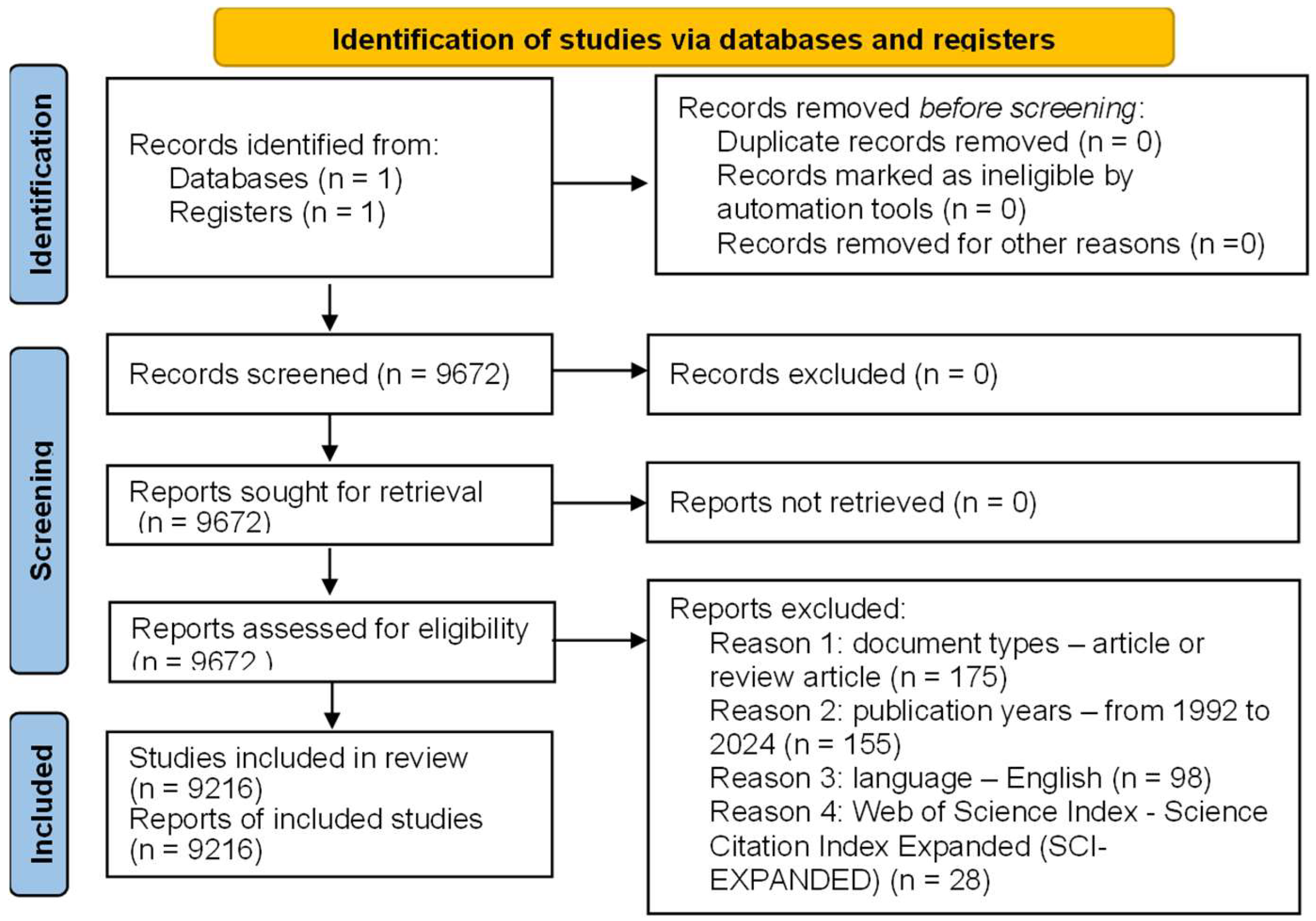
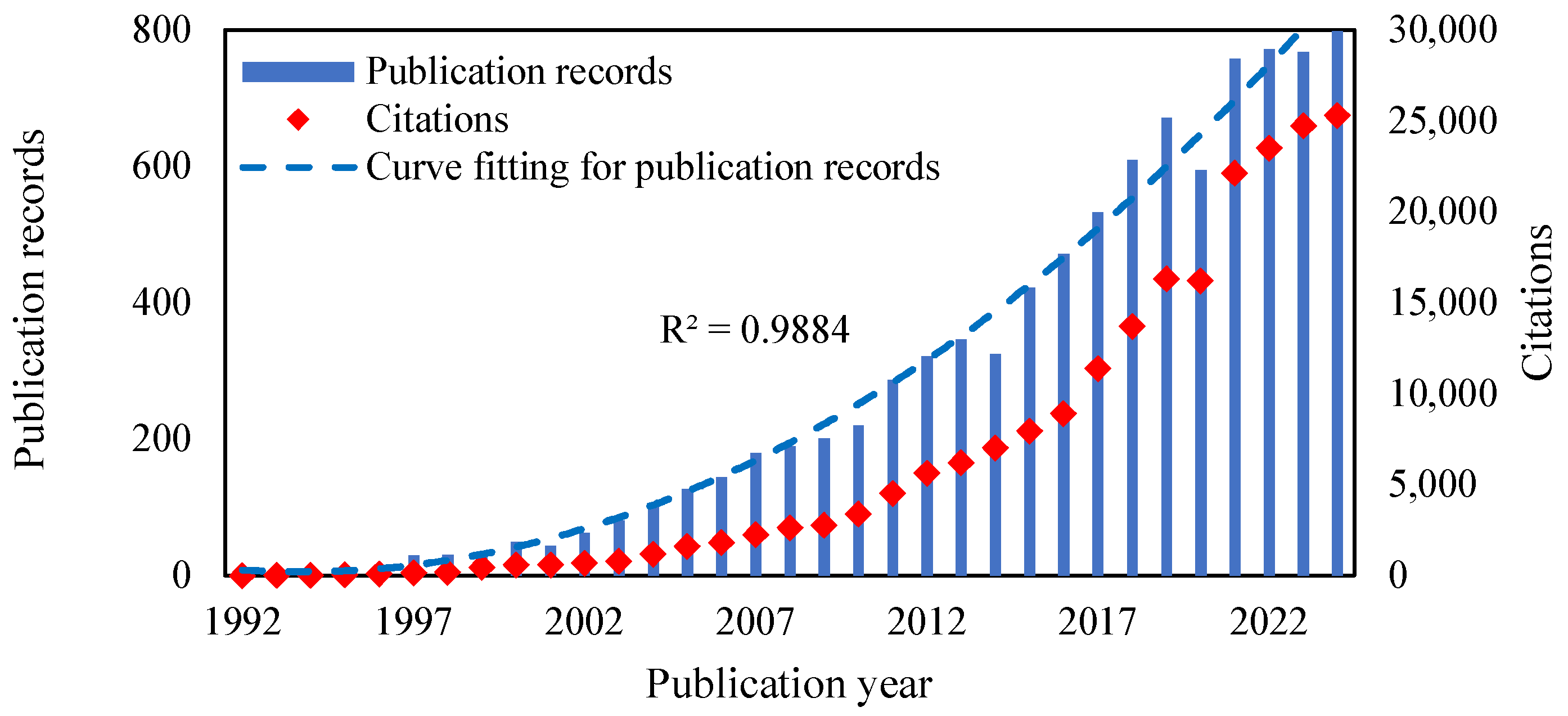
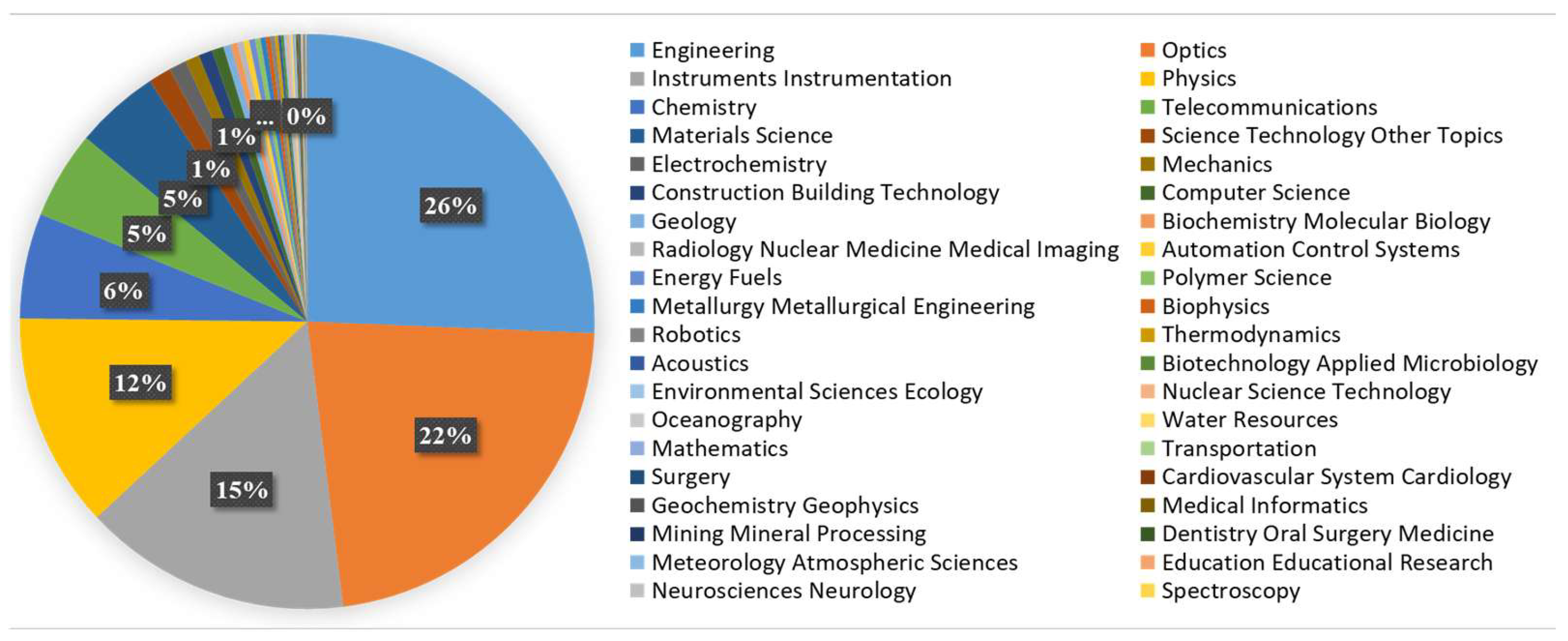
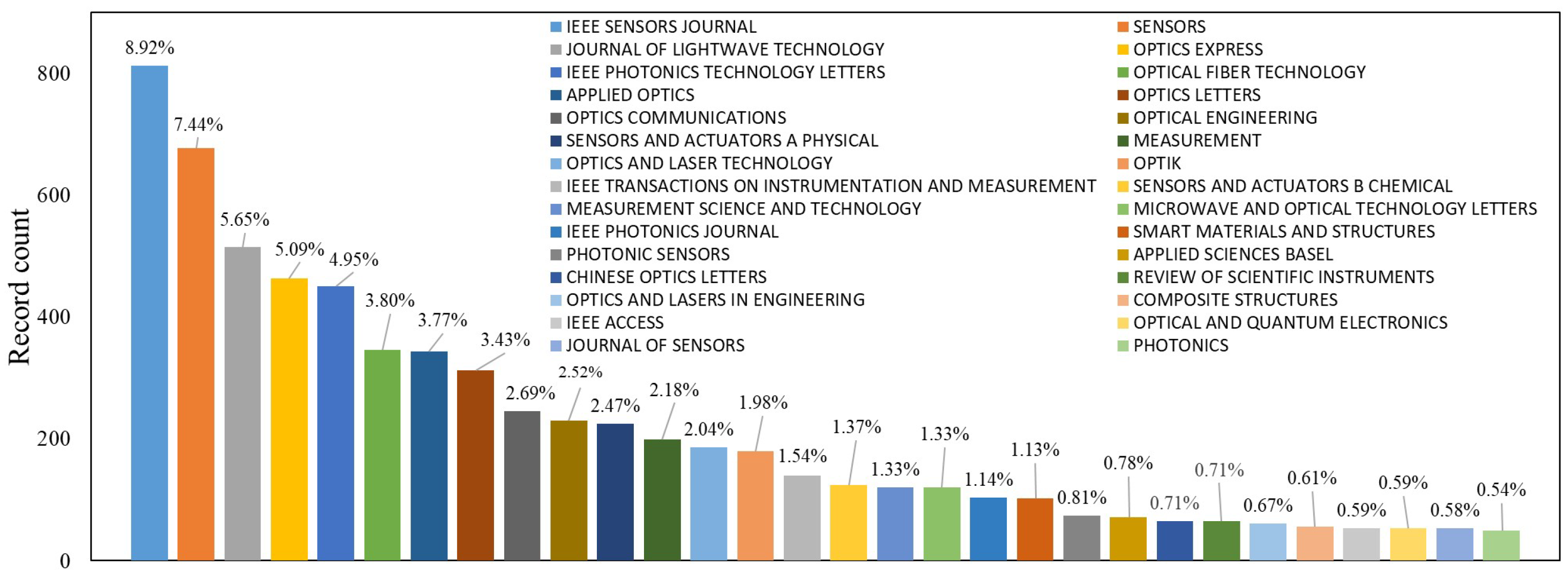
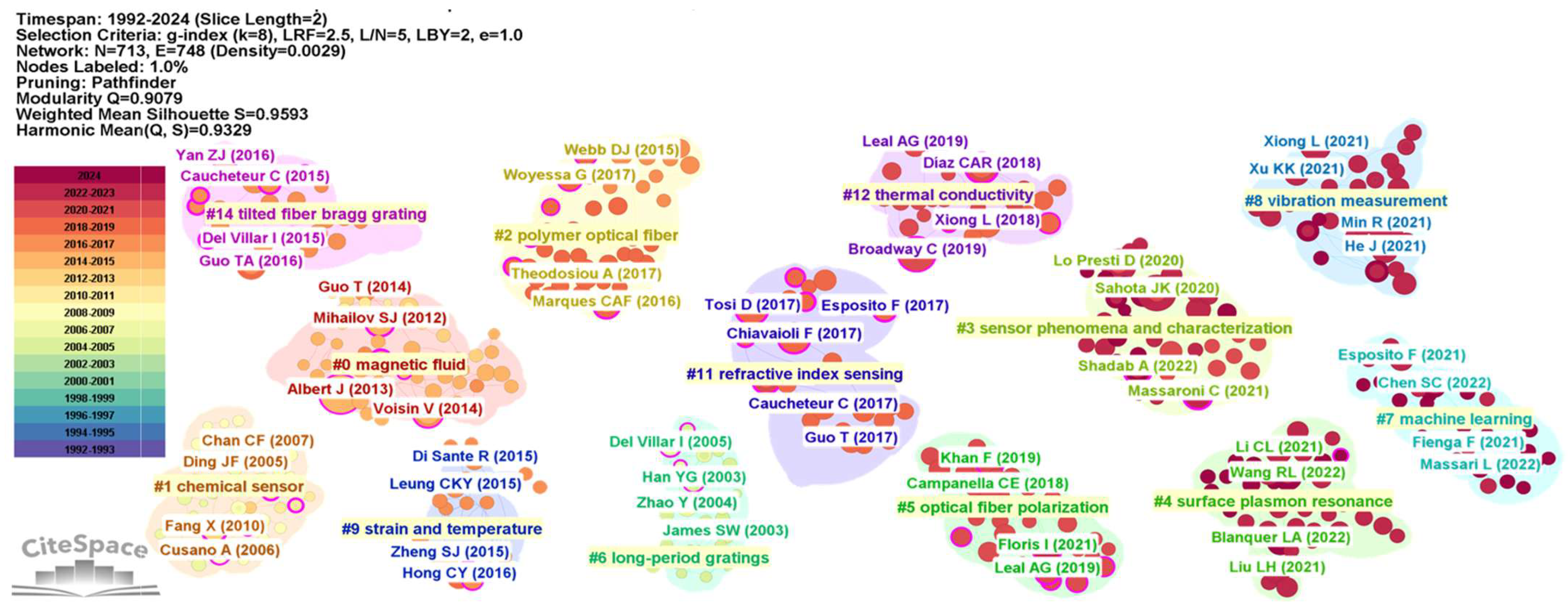
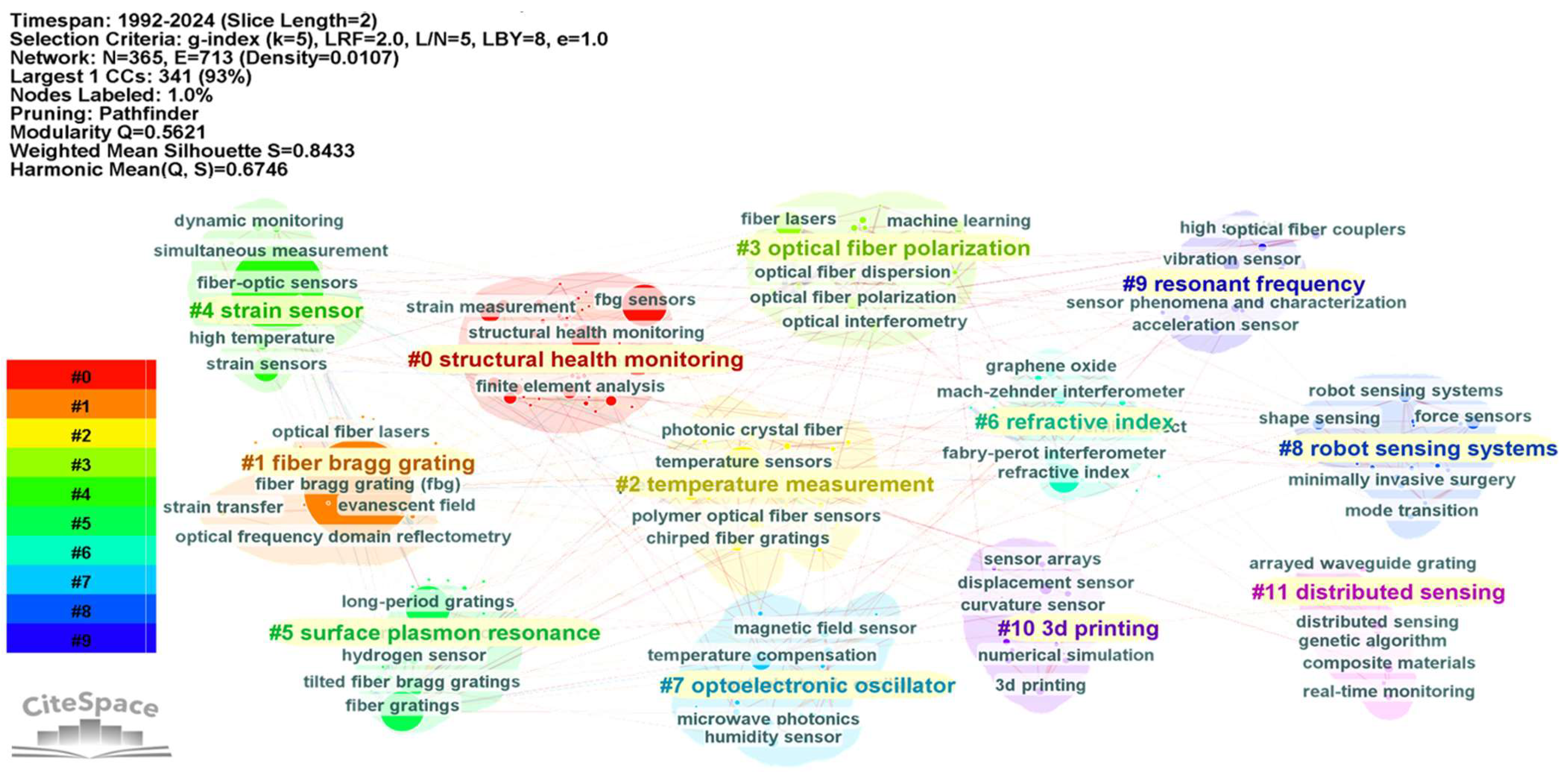
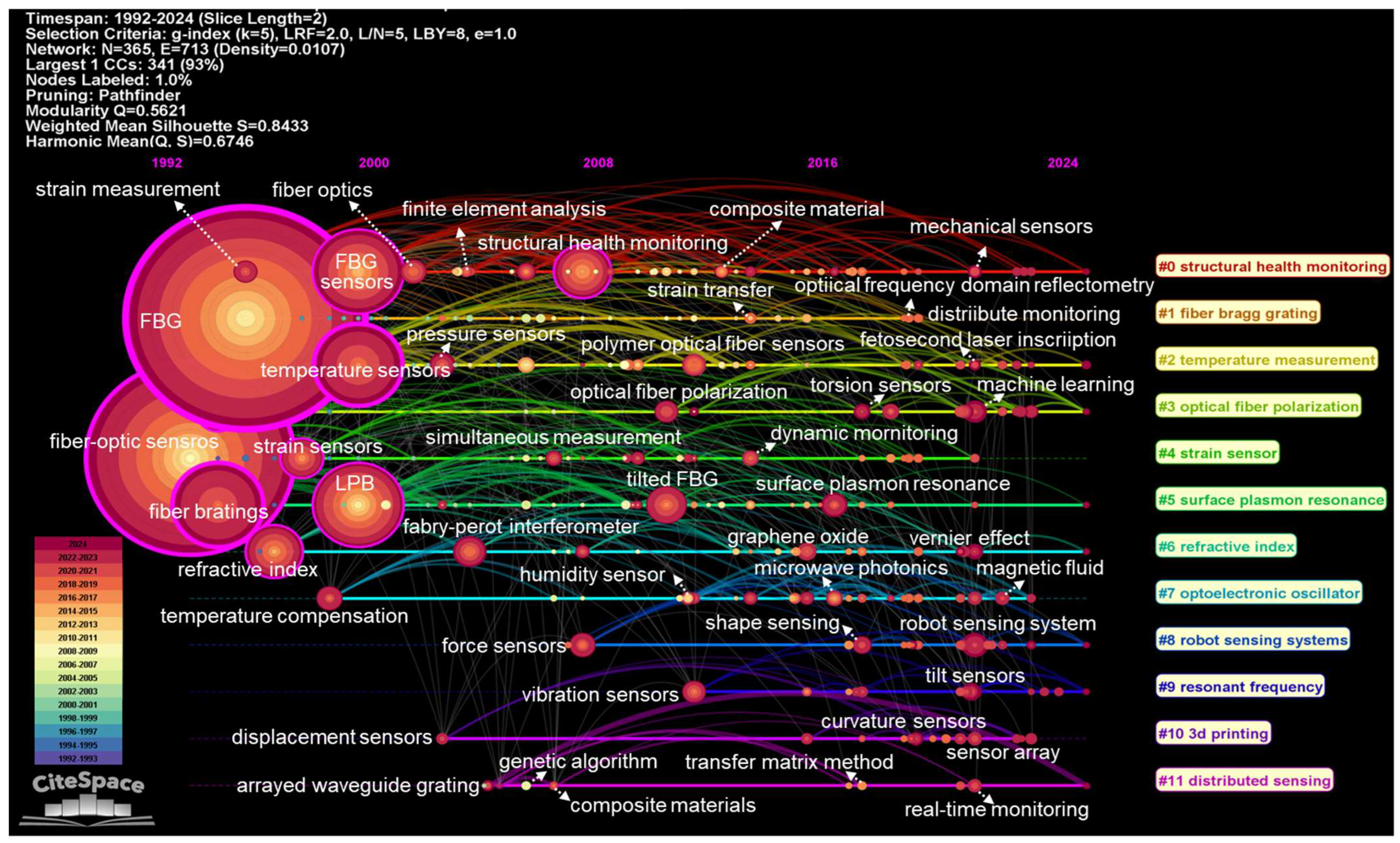
| Author | RC | % | CA | TC | H-i | Institution | Country |
|---|---|---|---|---|---|---|---|
| Caucheteur C | 109 | 1.196 | 3442 (3341) | 5388 (4867) | 41 | Univ. of Mons | Belgium/China |
| Marques C | 108 | 1.185 | 2381 (2287) | 4078 (3648) | 41 | Tech. Univ. of Ostrava | Czech/Portugal |
| Qiao X | 106 | 1.163 | 1378 (1300) | 2023 (1767) | 26 | Northwest Univ. | China |
| Yuan L | 101 | 1.108 | 967 (897) | 1327 (1179) | 21 | Guilin Univ. of Elec. Tech. | China |
| Guan B | 84 | 0.921 | 3254 (3197) | 4463 (4289) | 37 | Jinan Univ. | UK/USA/China |
| TAM H | 83 | 0.91 | 2891 (2842) | 3480 (3382) | 33 | Hong Kong Polytechnic Univ. | China |
| Albert J | 82 | 0.9 | 3021 (2947) | 5464 (5006) | 41 | Univ. of Ottawa | Canada |
| Cusano A | 75 | 0.823 | 2385 (2331) | 3122 (2992) | 35 | Univ. of Sannio | Italy/USA |
| Dong X | 70 | 0.768 | 2032 (1984) | 2560 (2461) | 34 | Guangdong Univ. of Tech. | China/Singapore |
| Zhu L | 69 | 0.757 | 496 (479) | 571 (542) | 13 | Beijing Info. Sci. & Tech.Univ. | China |
| References | Year | Strength | Begin | End | 1992–2024 |
|---|---|---|---|---|---|
| KERSEY AD, 1992, ELECTRON LETT., V28, P236, DOI 10.1049/el:19920146z | 1992 | 19.35 | 1992 | 1997 |  |
| Kersey AD, 1997, J.LIGHTWAVE TECHNOL, V15, P1442, DOI 10.1109/50.618377 | 1997 | 43.51 | 1998 | 2003 |  |
| Rao YJ, 1997, MEAS SCI TECHNOL, V8, P355, DOI 10.1088/0957-0233/8/4/002 | 1997 | 21.98 | 1998 | 2003 |  |
| James SW, 2003, MEAS SCI TECHNOL, V14, PR49, DOI 10.1088/0957-0233/14/5/201 | 2003 | 29.03 | 2004 | 2009 |  |
| Lee B, 2003, OPT FIBER TECHNOL, V9, P57, DOI 10.1016/S1068-5200(02)00527-8 | 2003 | 19.72 | 2004 | 2009 |  |
| Majumder M, 2008, SENSOR ACTUAT A-PHYS, V147, P150, DOI 10.1016/j.sna.2008.04.008 | 2008 | 30.93 | 2010 | 2013 |  |
| Albert J, 2013, LASER PHOTONICS REV, V7, P83, DOI 10.1002/lpor.20110039 | 2013 | 56.77 | 2013 | 2019 |  |
| Mihalov SJ, 2012, SENSORS-BASEL, V12, P1898, DOI 10.3390/s120201898 | 2012 | 35.34 | 2012 | 2017 |  |
| Kinet D, 2014, SENSORS-BASEL, V14, P7394, DOI 10.3390/s140407394 | 2014 | 28.48 | 2014 | 2019 |  |
| Guo T, 2016, OPT LASER TECHNOL, V78, P19, DOI 10.1016/j.optlastec.2015.10.007 | 2016 | 25.39 | 2016 | 2021 |  |
| Caucheteux C, 2015, ANAL BIOANAL CHEM, V407, P3883, DOI 10.1007/s00216-014-8411-6 | 2015 | 19.81 | 2016 | 2019 |  |
| Tosi D, 2017, SENSORS-BASEL, V17, P0, DOI 10.3390/s17102368 | 2017 | 25.28 | 2018 | 2023 |  |
| Hong CY, 2016, SENSOR ACTUAT A-PHYS, V244, P184, DOI 10.1016/j.sna.2016.04.033 | 2016 | 22.83 | 2018 | 2021 |  |
| Chiavaloni F, 2017, NANO PHOTONICS-BERLIN, V6, P663, DOI 10.1515/nanoph-2016-0178 | 2017 | 21.62 | 2018 | 2021 |  |
| Sahota JK, 2020, OPT ENG, V59, P0, DOI 10.1117/1.OE.59.6.060901 | 2020 | 43 | 2020 | 2024 |  |
| Campanella CE, 2018, SENSORS-BASEL, V18, P0, DOI 10.3390/s18093115 | 2018 | 34.67 | 2020 | 2024 |  |
| Lo Presti D, 2020, IEEE ACCESS, V8, P156863, DOI 10.1109/ACCESS.2020.3019138 | 2020 | 32.98 | 2020 | 2024 |  |
| Broadway C, 2019, J.LIGHTWAVE TECHNOL, V37, P2605, DOI 10.1109/JLT.2018.2885957 | 2019 | 20.74 | 2020 | 2024 |  |
| Li TL, 2020, IEEE SENS J, V20, P12074, DOI 10.1109/JSEN.2020.3000257 | 2020 | 26.26 | 2022 | 2024 |  |
| Min R, 2021, OPT LASER TECHNOL, V140, P0, DOI 10.1016/j.optlastec.2021.107082 | 2021 | 25.4 | 2022 | 2024 |  |
| Feature | OFGS | DFOS | Interferometric Optical Sensors |
|---|---|---|---|
| Sensing Principle | Bragg wavelength shift | Scattering (Rayleigh, Raman, Brillouin) | Interference pattern (Fabry–Pérot, Mach–Zehnder) |
| Spatial Resolution | cm (discrete points) | m/variable (continuous) | mm (requires precise calibration) |
| Measurement Range | Limited to sensor locations (km) | Long-range (>50 km) | Limited (typically, m) |
| Multiplexing Capability | Excellent with WDM/FDM techniques | Good but with lower resolution | Limited |
| Environmental robustness | Moderate (exposed fiber risk) | Good (embedded sensing possible) | Low (sensitive to temperature, vibration) |
| Cost per sensing point | High | Low | Very high |
Disclaimer/Publisher’s Note: The statements, opinions and data contained in all publications are solely those of the individual author(s) and contributor(s) and not of MDPI and/or the editor(s). MDPI and/or the editor(s) disclaim responsibility for any injury to people or property resulting from any ideas, methods, instructions or products referred to in the content. |
© 2025 by the authors. Licensee MDPI, Basel, Switzerland. This article is an open access article distributed under the terms and conditions of the Creative Commons Attribution (CC BY) license (https://creativecommons.org/licenses/by/4.0/).
Share and Cite
Deng, Y.; Ren, W.; Wang, X. Scientometric Analysis and Research Trends in Optical Fiber Grating Sensors: A Review. Photonics 2025, 12, 349. https://doi.org/10.3390/photonics12040349
Deng Y, Ren W, Wang X. Scientometric Analysis and Research Trends in Optical Fiber Grating Sensors: A Review. Photonics. 2025; 12(4):349. https://doi.org/10.3390/photonics12040349
Chicago/Turabian StyleDeng, Yiqiang, Wen Ren, and Xiaoyan Wang. 2025. "Scientometric Analysis and Research Trends in Optical Fiber Grating Sensors: A Review" Photonics 12, no. 4: 349. https://doi.org/10.3390/photonics12040349
APA StyleDeng, Y., Ren, W., & Wang, X. (2025). Scientometric Analysis and Research Trends in Optical Fiber Grating Sensors: A Review. Photonics, 12(4), 349. https://doi.org/10.3390/photonics12040349





